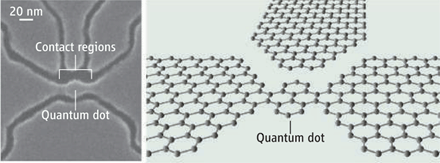The remarkable electronic properties of graphene – single, one-atom thick, sheets of graphite – are highlighted in a paper in this weeks Science magazine, which demonstrates field-effect transistors exploiting quantum dots as small as 10 nm carved out of graphene. The paper is by Manchester University’s Andre Geim, the original discoverer of graphene, together with Kostya Novoselov and other coworkers (only the abstract is available without subscription from the Science website, but the full paper is available from Geim’s website(PDF)).
A quantum dot is simply a nanoscale speck of a conducting or semiconducting material that is small enough that the electrons, behaving as quantum particles, behave in a different way because of the way in which they are confined. What makes graphene different and interesting is the unusual behaviour the electrons show in this material to start with – as explained in this earlier post, electrons in graphene behave as if they were mass-less, ultra-relativistic particles. For relatively large quantum dots (greater than 100 nm), the behaviour is similar to other quantum dot devices; the device behaves like a so-called single electron transistor, in which the conductance of the device shows distinct peaks with voltage, reflecting the fact that current is carried in whole numbers of electrons, a phenomenon called Coulomb blockade. It’s at sizes less than 100 nm that the behaviour becomes really interesting – on these size scales quantum confinement is becoming important, but rather than producing an ordered series of permitted energy states, as one would expect for normal electrons, they see behaviour characteristic of quantum chaos. Pushing the size down even further, the techniques being used give less control over the precise shape of the quantum dots that are made, and their behaviour becomes less predictable and less reproducible. Nonetheless, even down to sizes of a few nanometers, they see the clean switching behaviour that could make these useful electronic devices.
For more context, see this Commentary in Science (subscription required), and this BBC news story.

Left: Scanning electron micrograph of a single-electron transistor based on a graphene quantum dot. Right: Schematic of a hypothetical transistor based on a very small graphene quantum dot. A.K. Geim, University of Manchester, from Science 320 p324 (2008)
Graphene thin-films are hard to make. The deposition of stable thin-films is tricky and unreliable. The deposition technology has to be improved before Graphene thin-films and electronics make it to the prime time. If this hurtle can be overcome, I think that Graphene will take us to the ultimate limit of miniaturization where further progress is no longer possible. I expect this in the next 20 years.
Yes, there’s clearly lots of work to be done in making a technology out of graphene. On the other hand, the discovery is only four years old…